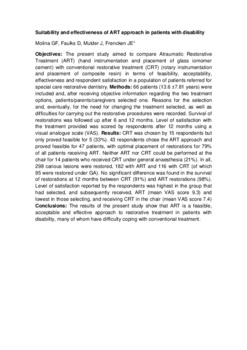| dc.contributor.author | Molina, Gustavo Fabían | |
| dc.contributor.author | Faulks, Denise | |
| dc.contributor.author | Mulder, Jan | |
| dc.contributor.author | Frencken, Jo | |
| dc.date.accessioned | 2021-10-25T13:32:50Z | |
| dc.date.available | 2021-10-25T13:32:50Z | |
| dc.date.issued | 2014 | |
| dc.identifier.uri | http://hdl.handle.net/11086/20995 | |
| dc.description.abstract | Objective: To assess the effectiveness and suitability of Atraumatic Restorative Treatment (ART) protocol in people with a disability.
Method: Three treatment protocols were distinguished: ART (hand instruments/high-viscosity glass-ionomer); conventional restorative treatment (rotary instrumentation/resin composite) in the clinic (CRT/clinic) and under general anesthesia (CRT/GA). People were referred for restorative care to a special care centre and treated by two specialists. Treatment allocation was performed by patients/parents/caregivers following a brochure-based selection procedure. Reasons for selection, need for changing the treatment selected and difficulties in performing the restorative procedures were recorded. Treatment satisfaction was determined using the Visual Analogue Scale (VAS). Evaluation was performed by two trained and calibrated examiners using the ART restoration assessment codes. The Proportional Hazard model with frailty corrections was applied to calculate survival estimates after 0.5 and 1 year.
Result: 66 patients (13.6±7.8 years) with 16 different medical disorders participated. CRT/clinic was chosen by 15 respondents (22.7%) but proved feasible for 5 (13%). 43 respondents (65.2%) chose the ART approach and proved feasible for 47 patients (71.2%), and 14 patients received CRT/GA (21%). In all, 298 dentine carious lesions were restored in primary and permanent teeth, 182 (ART), 21 (CRT/clinic) and 95 (CRT/GA). The 1-year survival rates and jackknife standard error of ART and CRT restorations were 97.8±1.0% and 90.5±3.2%, respectively (p=0.01). Level of satisfaction was highest for ART (mean VAS-score: 9.2±0.86) and lowest for CRT/clinic (mean VAS-score: 7.4±1.14) (p=0<0001).
Conclusion: The short-term results indicate that ART appears to be a suitable and effective treatment protocol for treating patients with disability restoratively, many of whom have difficulty coping with the conventional restorative treatment. | es |
| dc.description.uri | https://iadr.confex.com/iadr/14iags/webprogram/Paper188896.html | |
| dc.format.medium | Electrónico y/o Digital | |
| dc.language.iso | eng | es |
| dc.rights | Attribution-NonCommercial-ShareAlike 4.0 International | * |
| dc.rights.uri | https://creativecommons.org/licenses/by-nc-sa/4.0/ | * |
| dc.subject | Caries dental | es |
| dc.subject | Tratamiento restaurativo atraumático dental | es |
| dc.subject | Práctica profesional | es |
| dc.title | Suitability and effectiveness of ART approach in patients with disability | es |
| dc.type | conferenceObject | es |
| dc.description.fil | Fil: Molina, Gustavo Fabían. Universidad Nacional de Córdoba. Facultad de Odontología. Cátedra de Materiales Dentales; Argentina. | es |
| dc.description.fil | Fil: Faulks, Denise. Université Clermont Auvergne; Francia. | es |
| dc.description.fil | Fil: Mulder, Jan. Radboud University Medical Centre; Netherlands. | es |
| dc.description.fil | Fil: Frencken, Jo. Radboud University; Netherlands. | es |
| dc.description.field | Otras Ciencias de la Salud | |
| dc.conference.city | Alexandria | |
| dc.conference.country | Estados Unidos | |
| dc.conference.editorial | IADR | |
| dc.conference.event | IADR General Session | |
| dc.conference.eventcity | Ciudad del Cabo | |
| dc.conference.eventcountry | Sudáfrica | |
| dc.conference.eventdate | 2014-6 | |
| dc.conference.institution | IADR | |
| dc.conference.journal | Journal of Dental Research | |
| dc.conference.publication | Revista | |
| dc.conference.work | Artículo Completo | |
| dc.conference.type | Congreso | |





